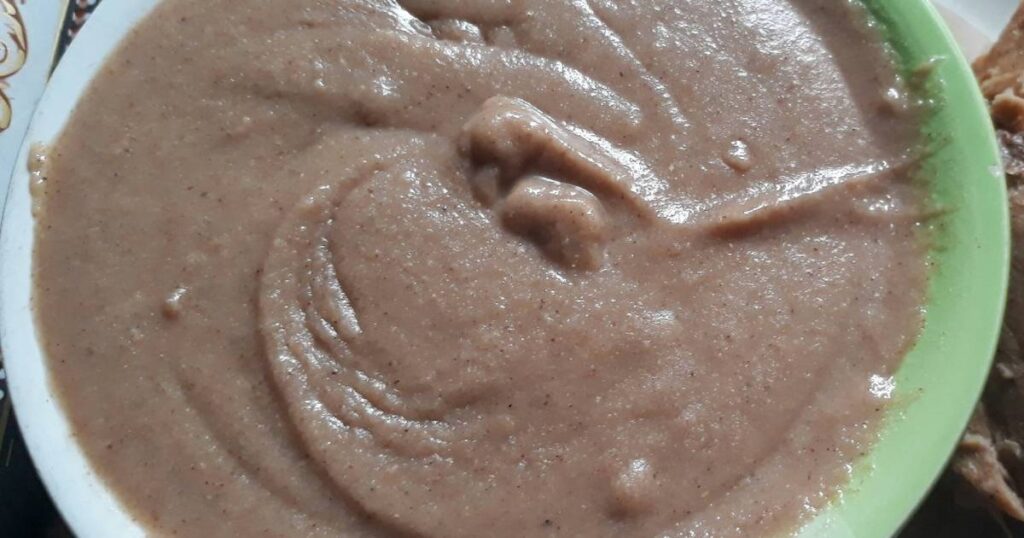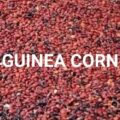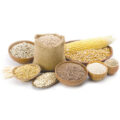Tom Brown is a thick mixture of yellow corn, millet, guinea corn (cereals), groundnut (peanuts) and soy beans (legumes). It’s one meal that is essential for babies if you want to wean them and want them looking well fed after breast milk. The cereals and legumes add a variety of nutrients beneficial to baby’s good health to the meal. Good nutrition during the first 2 years of life is vital for healthy growth and development. Starting good nutrition practices early can help children develop healthy dietary patterns. The FDA and CDC recommends that baby’s meal meet minimum nutritional and safety requirements.
This cereal is also good for adults who always have busy work schedules and may have to leave very early in the morning to their place of work. Nowadays, we spend most of our time being static while commuting to the job, sitting at a desk in the office, or relaxing on the couch. If we add the lack of time for exercise, then we get a perfect way to gain weight and live an unbalanced life. After a long day at the office and surviving rush hour traffic, the last thing on your mind is making a healthy meal. Tommy is just a 5 minutes meal. This will save you time and pack you up with essential nutrients especially if you are on the go.
What are the ingredients for making Tom brown?
The ingredients for making Tom brown include:
- Millet: is a whole grain that’s packed with protein, antioxidants, and nutrients. It may have numerous health benefits, such as helping lower your blood sugar and cholesterol levels. Plus, it’s gluten-free, making it an excellent choice for people who have celiac disease or follow a gluten-free diet. SEE: Health Benefits and Side Effects of Millet
- Guinea corn: this superfood is rich in micronutrients such as vitamins B, copper, iron, potassium, magnesium, etc. It not only has a lot of health benefits for adults but also for babies especially. This staple crop is a cereal grain that originated in Africa, in West Africa guinea corn is widely used in complementary feeding of babies and children. People eat it throughout the world. It is especially valuable in arid terrains because of its resistance to drought. Sorghum is a nutrient-rich grain that is often ground into flour. SEE: Health Benefits and Side Effects of Guinea corn
- Yellow corn: is a super food which also contains valuable B vitamins, that are important to your overall health. Corn also provides our bodies with essential minerals such as zinc, magnesium, copper, iron and manganese. Corn is a good source of the antioxidants carotenoids, lutein and zeaxanthin, which promote eye health.
- Soybeans: are an exceptional source of essential nutrients, Soy beans contain antioxidants and phytonutrients that are linked to various health benefits. Soymilk is high in proteins, iron, and a variety of vitamins crucial for the healthy development of infants. Soy milk is low in fat, which may help in maintaining healthy body weight in infants. It can further lower the risk of heart issues and child obesity in infants. SEE: Side Effects and Health Benefits of Soya Beans
- Groundnut: peanuts are as popular as they are healthy. They’re an excellent plant-based source of protein and high in various vitamins, minerals, and plant compounds. They can be useful as a part of a weight loss diet and may reduce your risk of both heart disease and gallstones.
How To Make Tom Brown
When making Tom Brown, size or quantity of the ingredients is of importance in its preparation. Here below is something you can start with.
- Yellow corn & Guinea corn(sorghum) – 1 kg
- Millet & Soy bean – 500g
- Groundnut (peanuts) – 200g
In summary, the corn (Yellow and guinea corn) is usually more in quantity than the rest of the ingredients when preparing the cereal. The millet and Soybeans is usually half the size of the Corn. While groundnut is lesser of all the main ingredients used. Note that apart from the nutritious value groundnut has, the groundnut enables the mixture to be pasty.
- Buy dried corn from the market, then roast it on fire until its turn brown and just before it starts popping like popcorn, remove it, leave to cool ( You can fry the two different types of corn together).
- Fry your groundnut
- Fry the millet and the soya bean. You have to fry everything separately
- After frying the soya beans, grind softly with mortal and pestle to remove the shaft, blow the shaft away with your mouth
- Leave everything to cool
- Combine all the ingredients together, if you have a high powered blender you can blend the mixture with your blender but if not, take it to the local mill to blend. The mixture should be blended dry (Do not add water!)
- Your Tom Brown mixture is ready! Pour it inside a dry container and preserve it.
ALSO SEE: Does Abidec Make Babies Gain Weight?
How to prepare Tom Brown porridge
It’s one thing to make the powder, it’s another to know how to prepare it so it doesn’t turn out lumpy, the key to achieving a silky smooth porridge is to stir it constantly especially at the beginning of the cooking just like semo).
- Place a small pot on fire, pour small water into it, then make a thick mix of tom brown powder with water and pour it into the pot
- Using a turning stick, turn until there’s no lump in the mixture
- Continue turning it until it becomes thick like custard and looks cooked
- The fire should be on a medium heat, cook for about 7 minutes until it becomes firm, cooked and smooth.
Your tom brown is ready, you can serve with baby milk and adults can further fortify their tom brown meal with fresh, powdered or evaporated milk which provides additional nutrients needed for healthy bones: protein, calcium, vitamins A and D. SEE: 10 Good Food That Makes Baby “Fat” in Nigeria
Nutrition and Your Growing Baby
Some of the nutrients babies need to grow and stay healthy include:
Calcium. Helps build strong bones and teeth.
Fat. Creates energy, helps the brain develop, keeps skin and hair healthy, and protects against infections.
Folate. Helps cells divide.
Iron. Builds blood cells, and helps the brain develop. Breast-fed babies should receive iron supplements.
Protein and carbohydrates. They provide energy and fuel growth.
Zinc. Helps the cells grow and repair themselves
Your baby also needs vitamins such as:
Vitamin A. Keeps skin, hair, vision, and the immune system healthy.
Vitamin B1 (thiamine). Helps the body turn food into energy.
Vitamin B2 (riboflavin). Helps the body turn food into energy, and protects cells from damage.
Vitamin B3 (niacin). Helps the body turn food into energy and use fats and protein.
Vitamin B6. Keeps the brain and immune system healthy.
Vitamin B12. Keeps nerve and blood cells healthy, and makes DNA — the genetic material in every cell.
Vitamin C. Protects against infections, builds bones and muscles, and helps wounds heal.
Vitamin D. Helps the body absorb calcium from food, and keeps bones and teeth healthy. Breast-fed babies may need a D supplement.
Vitamin E. Protects cells from damage, and strengthens the immune system.
Vitamin K. Helps the blood to clot. READ: Health Benefits and Side Effects Of Groundnut Water






